About Daily Cusack
Blogs
- Rorate Caeli
- First Things blog
- Sancrucensis
- Ex Laodicea
- Millinerd
- American Conservative blogs
- Spoils of Egypt
- Sam Kriss
- Paraphasic
- Eunomia
- Irish Aesthete
- Classicist
News
- BBC News
- Daily Telegraph
- Spectator
- Catholic Herald
- First Things
- American Conservative
- New Criterion
- London Review of Books
- Frankfurter Allgemeine
- Neue Zurcher Zeitung
- ConservativeHome
- CapX
- Arts & Letters Daily
- Buenos Aires Herald
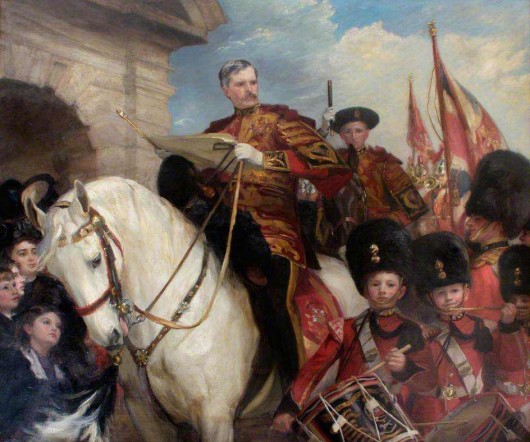
c. 1911; Oil on canvas, 68 in. x 76.9 in.
A triumphant painting, but a last hurrah. The central figure is Sir Nevile Wilkinson, the last ever Ulster King of Arms & Principal Herald of Ireland, exercising the duties of his office by proclaiming the accession of the new king at Dublin Castle.
The Anglo-Irish Treaty and its legislative acts neglected to make provision for transferring this ancient office to the new Irish Free State, but Sir Nevile carried on regardless for nearly two decades, even issuing two dozen grants of arms on the day before his death in 1940.
After his death, the Oireachtas created the office of the Chief Herald of Ireland to continue the granting of arms, and in some sense the Chief Herald is a spiritual successor to the Ulster King of Arms.


Staatspresident Jacobus Johannes Fouché giving the staatsrede from the throne of the Senate within the Houses of Parliament in Cape Town.
What is now the State of the Nation Address has its origins in the speech from the throne (in Afrikaans staatsrede meaning “state reasoning/rationale”) setting out the Government’s legislative programme for the year. The high point of the State Opening of Parliament, it was originally given by the Governor-General (or, in 1947, by the King of South Africa himself) but with the abolition of the monarchy in 1961 the sovereign’s vice-regal representative was abolished and replaced by the Staatspresident as chief officer of the South African state.
Giving a speech from an actual throne was considered too monarchic for a republican polity, so – like in the Boer republics of old – presidents gave their staatsredes standing. Here, State-President Fouché is flanked by the chiefs of the defence staff and police, the Serjeant-at-Arms with the mace, and the Gentleman Usher of the Black Rod.
Of course, much of this was abolished in the 1980s with the constitutional innovations as a last-ditch attempt to entrench apartheid. South Africa is now on its third constitution since the above photo was taken.
It reminds me of how in Ireland almost all the traditions of the Viceroy (viz. the Viceregal Guard of Battleaxes, etc.) were abolished not by the Saorstát or Éire but by the British themselves – in their case by penny-pinching Victorians who found Dublin an easy target for cost-cutting.


1830; Oil on canvas, 15½ in. x 13½ in.
I love the underappreciated Biedermeier, whether in art or literature, and this is a very Biedermeier painting.
The painter’s father, Charles de Moreau, was an architect – indeed he designed the very building that the son depicts here. As it happens, the painting now hangs in the Wien Museum am Karlsplatz, across from the main building of the Imperial & Royal Polytechnic Institute (now the Vienna University of Technology) which his father also designed.
Nikolaus painted this scene when he was twenty five, and he died just four years later not having reached his thirtieth year.

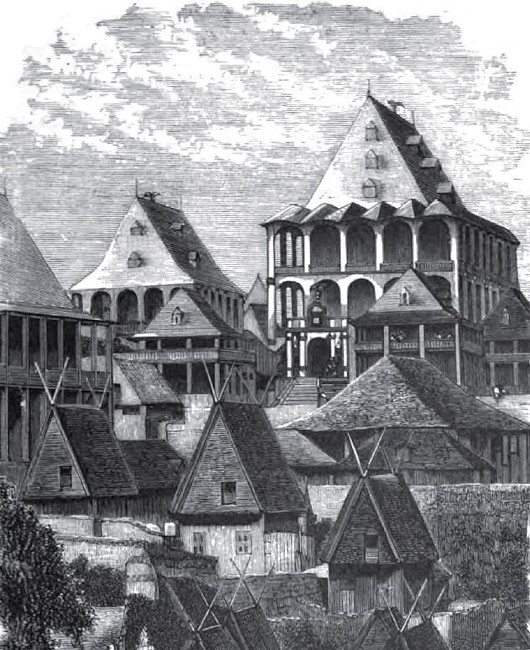
The Rova of Antananarivo
The Tranovola (left) and Manjakamiadana (right) in the Rova of Antananarivo.
The Manjakamiadana (“Where It is Pleasant to Rule”) was the royal residence, later pretentiously clad in stone by Protestant missionaries, while the Tranovola (“Silver House”) was where the nefarious Rainivoninahitriniony received foreign diplomats after the nobles’ coup of 1863.
His complicity in the supposed regicide of that year — no one’s really quite sure what happened to Radama II — eventually led to his downfall two years later. His younger brother Rainilaiarivony proved a more skilful political operator, succeding Rainivoninahitriniony as prime minister and arranging his own marriage to the last three queens of the Merina kingdom of Madagascar.

Daily Cusack: Monday 18 January 2016

– Architectural historian Catesby Leigh looks at Ralph Adams Cram and Pittsburgh’s gothic architectural legacy.
– In October for the first time ever Polish voters handed a parliamentary majority to a single party, putting the Law and Justice (PiS) party in power after nine years in opposition. But, alarmed by the new government’s attempts to correct the stacking of state media by their political opponents, western European powers have attacked the new government and suggested it be investigated by the European Union.
The PiS delegation of the European Conservatives & Reformists Group in the European Parliament has released a measured statement asking What is really happening in Poland? Given recent events in Cologne, however, Polish fans at a volleyball match in Berlin viscerally suggested the Germans should get their own act in order before criticisng others.
– Polish academic Artur Rosman explores both the history and future of the pro-life movement in America, citing the New York Times’s Kristen Dombek’s surprise at discovering that abortion is not an exclusively conservative concern:
Among those of us who wish to protect access to abortion, it’s easy to feel that “right to life” language is a cover for an attack on feminism. It’s a feeling supported by a common story about history: The anti-abortion movement began after Roe v. Wade, because conservative evangelicals were threatened by women’s newfound power over their bodies. What else could explain the movement’s swift rise in the decade following the Supreme Court’s decision, if not a widespread reaction against equal rights? […]
[I]t’s hard to imagine a country where the most prominent voices against abortion were Catholic physicians, and evangelical Protestants were either in favor of lifting restrictions on abortion, or didn’t really care. A country where Democrats and the Black Panthers opposed abortion, and Ronald Reagan, like most conservatives, supported it. Where more men than women supported legalizing abortion, and Hugh Hefner was one of those men, leading one activist to call legalized abortion the “final victory of the Playboy philosophy.” Where opposition to abortion found common cause with opposition to the exploitation of women, to the abandonment of the poor, to big business and to the Vietnam War.
– And finally, Sam the Eagle has a message for all the prospective candidates in the American presidential election:

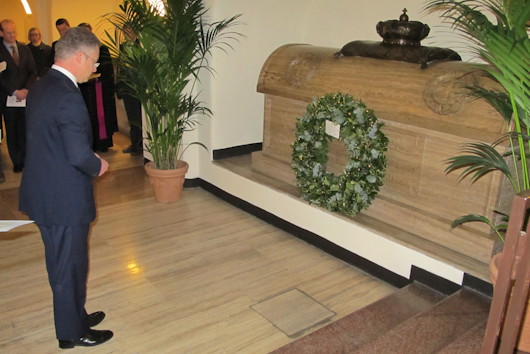
On the two-hundred-and-fiftieth anniversary of his state funeral in Rome, James III & VIII was remembered with a wreath-laying by Her Majesty’s Ambassador to the Holy See, Nigel Baker. The message on Nigel’s wreath read simply ‘In memoriam – James Francis Edward Stuart – ‘The Chevalier’ – 1688-1766’.
As the Ambassador notes in his blog post:
[O]ur simple wreath-laying ceremony was, in a way, one of historical reconciliation. The Chevalier always considered himself a patriot, and his court in exile welcomed Britons of all political and religious stripes. His younger son, Henry Benedict, Cardinal York, received a pension from the British Crown after his lands had been seized by Napoleon, and the Prince Regent offered to contribute to the magnificent Stuart monument by Canova that can still be seen in St Peter’s. The tomb in the crypt where I laid the wreath was restored by Queen Elizabeth the Queen Mother, through the good offices of my predecessor, Sir D’Arcy Osborne, in the early 1940’s. And in 2012 HRH The Duke of Gloucester unveiled a restored Coat of Arms of Cardinal York in the Pontifical Scots College, where the original Stuart gravestones had been transferred.
James III was the last of the Jacobite claimants to the English, Scots, and Irish thrones to be recognised by the Pope. He was succeeded in the line by his eldest son Charles (Bonnie Prince Charlie) and, after Charles’s death, by James’s second son Henry, who — having been ordained a priest, then a bishop, and being created a cardinal — was generally known as the Cardinal Duke of York.
Cardinal Comastri — Archpriest of St Peter’s Basilica, President of the Fabric of St Peter’s, and Vicar General of the Vatican City State — took part in the ceremony and also present were Lord Nicholas Windsor, and the Rectors of the Venerable English College, the Pontifical Scots College, the Pontifical Irish College, and the Pontifical Beda College, the Polish Ambassador to the Holy See (in honour of James’s wife Queen Maria Clementina), and the Irish Ambassador to the Holy See.
“The presence of the Irish ambassador to the Holy See,” Nigel notes, “also reminded us of the importance of commemorating together, rather than remembering apart. The past leaves many wounds. But do not underestimate the healing power of history and remembrance, done well.”
Also a sign, one might add, of what good value we get out of this most unique of British diplomatic postings.

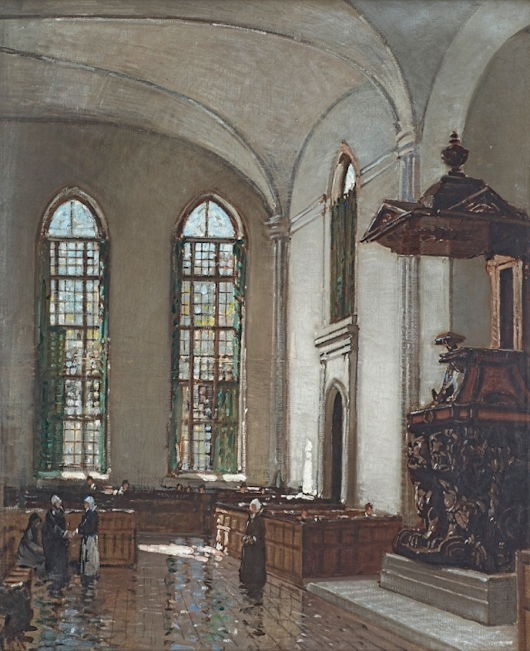
1916; Oil on canvas, 29½ in. x 24½ in.
Though the painting is just a hundred years old, Gwelo Goodman depicted the scene as if in the late seventeenth century — when the Groote Kerk was first built.
While the body of the church was replaced in the 1840s, the elders of this most senior Nederduits Gereformeerde gemeente wisely kept the stunning baroque pulpit, the work of the Cape’s greatest sculptor Anton Anreith.

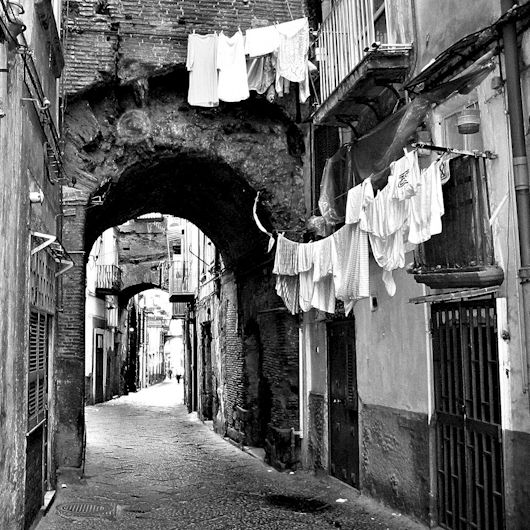
THERE ARE CITIES that defy the centuries; time does not change them. Empires succeed each other, civilisations leave their remains in them like geological strata, but they preserve their character through the ages, their peculiar ambience, the sound and rhythm which distinguish them from all other cities upon the earth. Naples is one of these cities, and it appears to the traveller today, as it was in the Middle Ages, and doubtless a thousand years before, half-African, half-Latin, with its terraced alleys, its street-cries, its smell of olive oil, charcoal, saffron and frying fish, its sun-coloured dust, the sound of bells ringing on the necks of horses and of mules.
The Greeks founded it, the Romans conquered it, the barbarians despoiled it, the Byzantines and the Normans each in turn took possession of it as masters. But they did no more than modify a little the architecture of its houses and add certain superstitions, a few legends, to the traditions of its streets.
The population is neither Greek, Roman nor Byzantine; the people are Neapolitan in perpetuity, a population distinct from all others in the world. Their gaiety is but a facade concealing the tragedy of poverty, their magniloquence an accent relieving the monotony of the daily round, their leisure a virtue in refusing to pretend to be busy when there is in fact nothing to do; its population is life-loving, meeting the setbacks of fate with guile, with a gift of speech and a contempt for all things military because peace never becomes boring. …

Daily Cusack: Tuesday 12 January

– Imagine you find out your mother has been killed. Then imagine her killer not only goes unpunished but that he’s subject to a continual stream of awards and honours. At school your son is handed a leaflet promoting the man who ended his grandmother’s life. The only objectors (Catholics and Holocaust survivors) are easily brushed aside.
This isn’t an alternate universe: this is Belgium today, as the New Yorker reports. (via M.B.D.)
– Fr Edmund Waldstein relates a stimulating dialogue upon Star Wars between Over-Bearing, Past-Bearing, and Baring (with a cameo appearance from Duff Cooper).
– I’ve mentioned Tolkein and his love of Finnish before. More recently, the BBC inquired about Finland’s influence on the writer.
– “It’s the most nauseating display in American public life,” says Kevin D Williamson in his splendid jeremiad, “and I write that as someone who has just returned from a pornographers’ convention.”
– Fredrik de Boer puts his head above the parapet and gives us a little insight into how things work.
– And finally, some good news: a study claims French is set to overtake Chinese as the world’s most widely spoken language by 2050. (But, as P.E.G. noted in 2014, the methodology is a bit dodgy.)
Let’s hope they’re reading Bossuet rather than Voltaire.



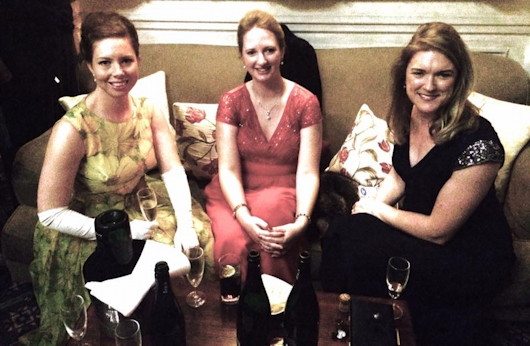
The Cusackian table used to be the only one having our pre-ball drinks at the Cavalry & Guards Club (thanks to Maj Ibbs & Capt de Stacpoole) but this year the place was choc-a-bloc with ballgoers. Our ladies were looking particularly lovely, though there were moments when various of their fur accoutrements were redeployed as judges’ wigs and sentence was passed on those worth of condemnation.
Despite the rather late hour I left the after-party, I somehow made it to the 11 o’clock mass at the Oratory the following morning and noticed a somewhat depleted congregation (though added to by the presence of Gerald Warner up from Scotland). Very wisely the ball organisers arrange a special afternoon mass at 2 o’clock for survivors, but by the time it commenced I had not only already fulfilled my Sunday obligation but also downed a delicious plate of pappardelle and was en route back home to bed and further recovery.

Daily Cusack: Friday 8 January 2016

– Ross Douthat’s sensitive and thoughtful commentary on the state of the Catholic church (in the New York Times, of all places) has previously sparked apoplexy on the part of liberals, hilariously inspiring a host of bien-pensant establishment lefties to point out he has “no professional qualifications for writing on the subject”.
In a recent blog post, Douthat points out how difficult it is to engage in dialogue with lefty Catholic thinking given that it often assumes we can reinterpret anything whenever we want while ignoring centuries of fervent intellectual inquiry and church teaching. For these liberals, it is always Catholicism: Year Zero.
– The British writer Tibor Fischer is no conservative, but he’s often written how ridiculous it is for people to claim the Viktor Orbán is a dictator, whether in the Guardian or in Standpoint. (I myself had to take to the pages of the Irish Times to defend the Hungarian PM.)
Now Fischer writes in the Telegraph asserting that Viktor Orbán is no fascist: he’s David Cameron’s best chance at reforming the European Union.
– Still in Hungary, the British Embassy in Budapest is moving out of its home of nearly seventy years and into the recently vacated Dutch embassy.
– Everyone loves the leader of the Scottish Conservatives, Alex Massie says. But still no one will vote for her.
– Agnostic Southern Episcopalian chain-smoking monarchist with a penchant for misanthropy: Florence King, RIP.
– Speaking of misanthropy, is Groucho Marx’s humour nihilist? Shon Arieh-Lerer thinks Lee Siegel’s book might be overthinking things a bit.
– And finally, the United Nations Library in New York has announced which of its books was checked out the most often in 2015: Immunity of heads of state and state officials for international crimes.


Borris House
The County Carlow seat of the MacMorrough Kavanaghs, ancient Kings of Leinster, whose sixteenth generation live here still.

